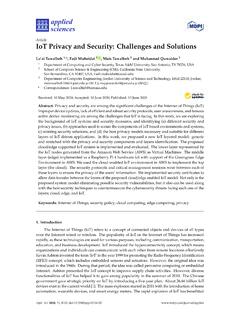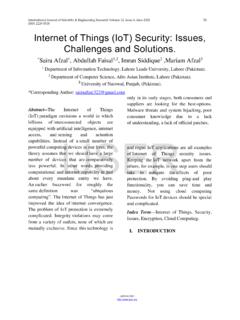Transcription of Management Integration: Benefits, Challenges and Solutions
1 IIRSM Technical Paper: Management Integration: Benefits, Challenges and SolutionsIan Dalling (CQI Integrated Management Special Interest Group) andBarry Holt (IIRSM)March 20121 | P a g e IIRSM Technical Paper: Management Integration: Benefits, Challenges and Solutions Management Integration: Benefits, Challenges and Solutions By Ian Dalling, CQI Integrated Management Special Interest Group & Barry Holt, IIRSM Contents Page I. Abstract 2 II. Introduction 2 III. What do we understand by integration? 5 IV. Integration of the different disciplines 6 V. Unifying principles that support integrated Management 18 VI.
2 Conclusion 24 VII. References 26 2 | P a g e Management integration: Benefits, Challenges and Solutions Barry Holt, Director of Policy and Research, IIRSM Ian Dalling, Chair of the Chartered Quality Institute Integrated Management Special Interest Group Abstract With a plan-do-check-act and risk based approach being applied to health, safety, quality and environmental Management , we have seen the development of individual standards, such as ISO 9001 ISO14001 and OHSAS 18001. Between the risks in each of these areas and the way they can be managed, there is much that is common.
3 As a result, many organisations are merging the fragmented Management systems into a single integrated Management system. In addition, with the increasing acceptance that all these types of risk can be seen as threats to the business, organisations are now looking at how business opportunity and risk can be universally managed using a truly integrated Management system that covers the totality of the business operations. This paper addresses; the unifying principles that support integrated Management , the benefits of different approaches as well as the barriers which need to be overcome and concludes that integrated Management provides an opportunity to manage organisations much more effectively and efficiently.
4 1. Introduction Historically health and safety, along with other risk areas such as quality and environmental Management have been viewed by organisations as disciplines which may be necessary but which are not directly related either to each other or to the core activities of the business. However, in the 1950s the work which was instituted in Japan by Deming and Juran, related to statistical process control and quality Management systems demonstrated that the benefits of viewing this as an integral component of business were clear. Subsequent developments have led to concepts such as Total Quality Management , Six-Sigma, Kaizen and many others including the establishment of the ISO 9000 series of quality assurance standards.
5 These are based on the principle that the quality of a product and the consistency with which it is produced are the result of a process and it is this process on 3 | P a g e which the ISO 9000 standard is focussed. In fact, in its original format ISO 9000 was criticised for being a consistency standard which could have been achieved by organisations that did not produce high quality output even though the public perceived it as almost a guarantee. This was rectified when the standard was reviewed and ISO 9000: 2000 introduced the requirement for a continuous improvement programme to be in place.
6 In 1989, a model for quality Management had been established by the European Foundation for Quality Management whose Excellence Model is used by more than 30,000 organisation, mainly in Europe. This requirement for continuous improvement had been incorporated in the ISO 14000 series of environmental Management standards which were published in 1996 which in turn developed out of BSI standard BS 7750, published in 1992, the year of the Earth Summit in Rio de Janeiro. This standard was also based on the belief that responsible environmental Management was a benefit for businesses although this was being increasingly driven by legislative changes.
7 In particular many countries were introducing the principle that the polluter pays . In other words, in addition to direct penalties such as fines, environmental pollution could result in the clean-up costs being met by the organisation responsible. This has been highlighted by a number of major incidents, most recently the BP Deepwater Horizon incident in the Gulf of Mexico in April 2010. In addition to being the second largest oil spill in US history, this incident proved that there is a close link between Management of environmental risks and health and safety as it also resulted in the deaths of eleven employees.
8 In the US, comprehensive environment legislation was introduced in 1969 with the passing of the National Environmental Protection Act. In the UK, we have seen the introduction of the Environment Protection Act 1990 and the Environment Act 1995 which were aimed at controlling the more polluting industries. In contrast to the development of quality and environmental Management the protection of employees has been driven primarily by legislation. In the UK, following the rapid development of the factory system, in 1802 the Health and Morals of Apprentices Act was introduced with the aim of controlling working conditions of children employed in textile mills.
9 This then led to the introduction of a whole series of Factories Acts between 1844 and 1961. In the US, a law was passed in the state of Massachusetts requiring safeguarding of machinery and in 1970 the Occupational Safety and Health Act was introduced, founding 4 | P a g e the Occupational Safety and Health Agency (OSHA) and the National Institute for Occupational Safety and Health (NIOSH). This led to the establishment of specific standards for hazardous activities. Historically, most of this legislation was prescriptive, in that it related to specific activities and their required control measures.
10 In the UK in 1972 a committee was established under Lord Robens to review the basis of UK health and safety legislation. The report recommended a major shift toward a risk based approach which required employers to set standards aimed at safeguarding the health, safety and welfare of their employees and others. This approach was incorporated into the Health and Safety at Work, etc. Act 1974 and has subsequently been built into the risk based approach of the EU. The recent review of UK legislation carried out by a committee chaired by Prof. Ragnar L fstedt has underlined this commitment to a risk based approach.








